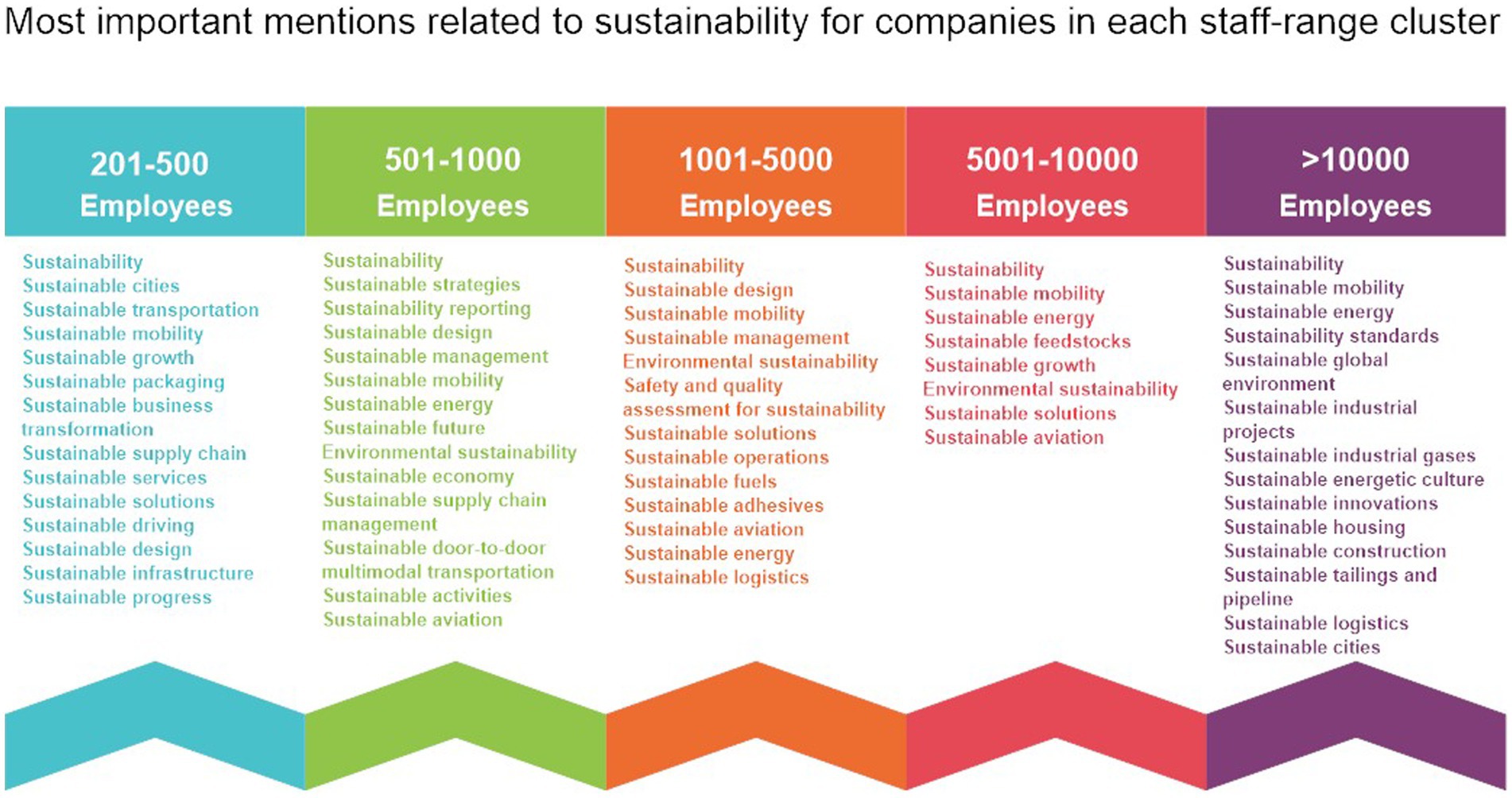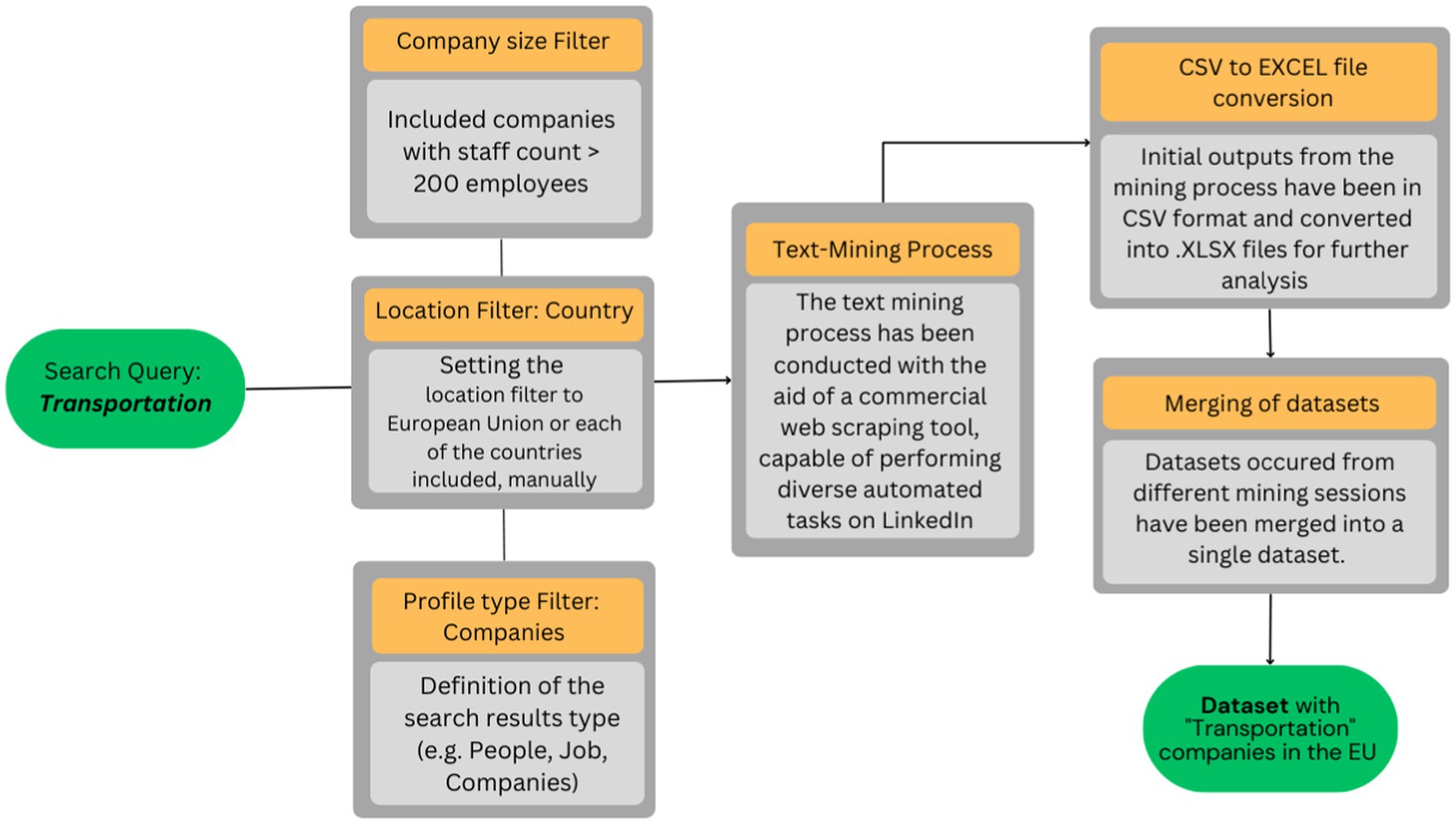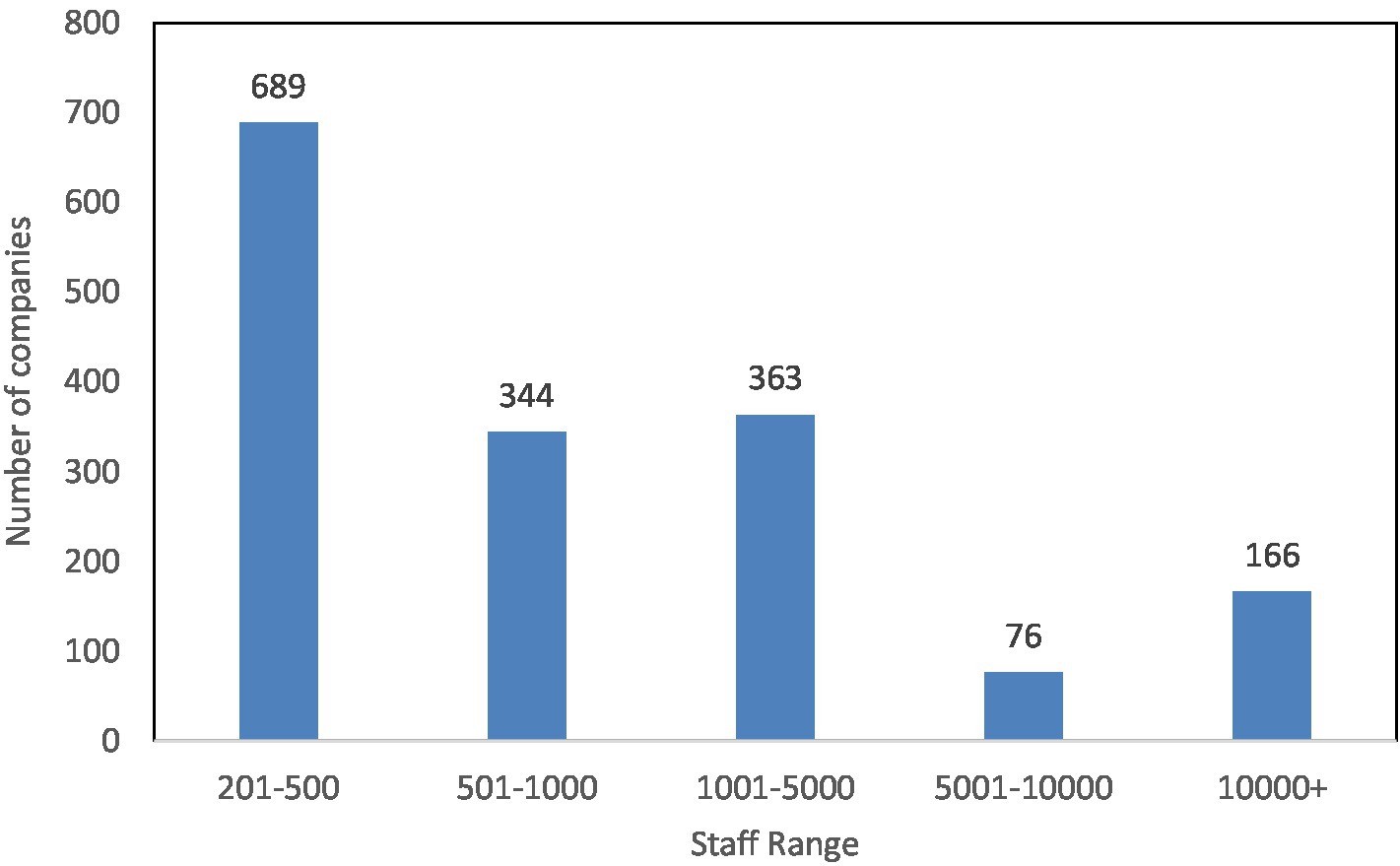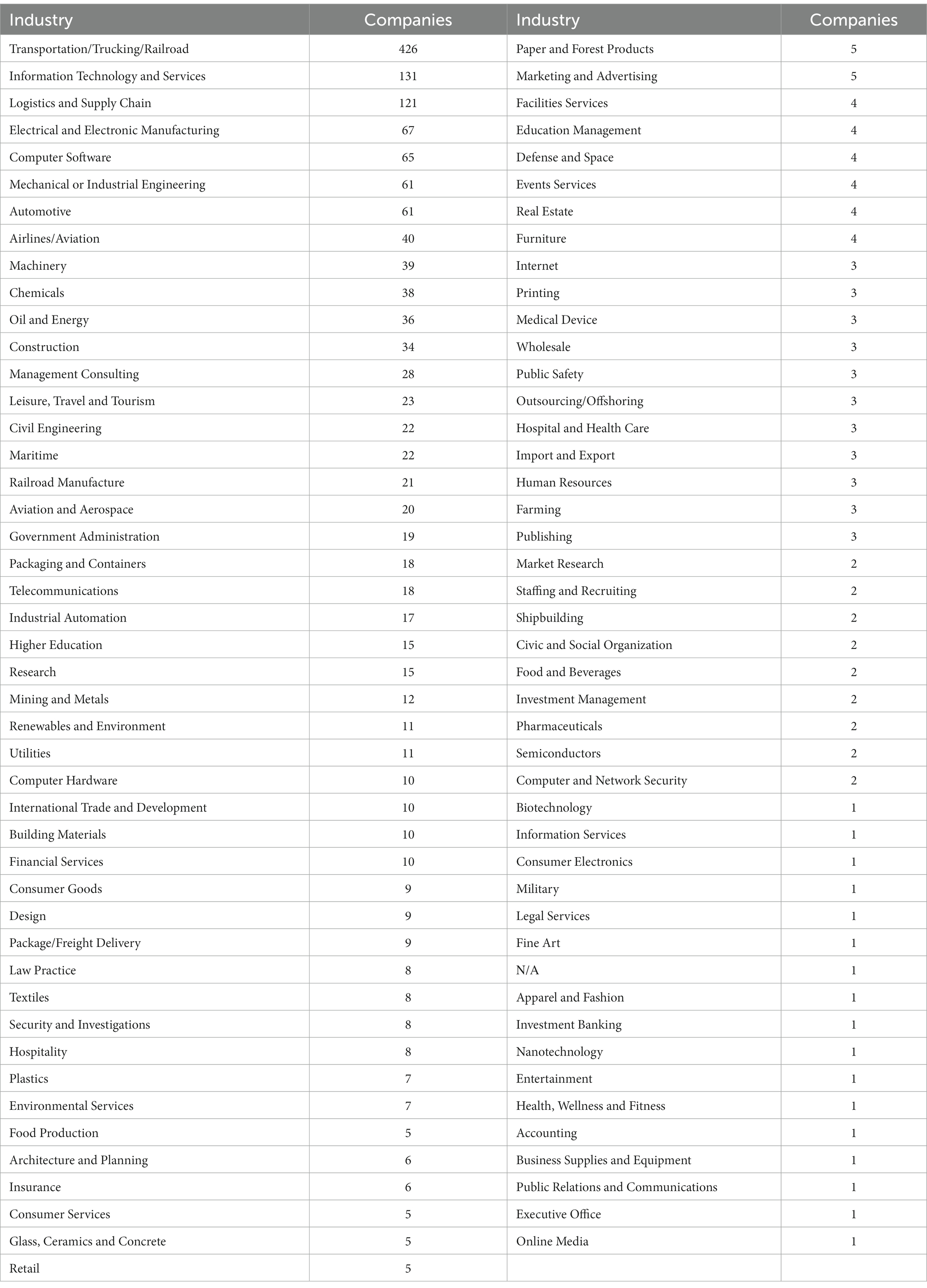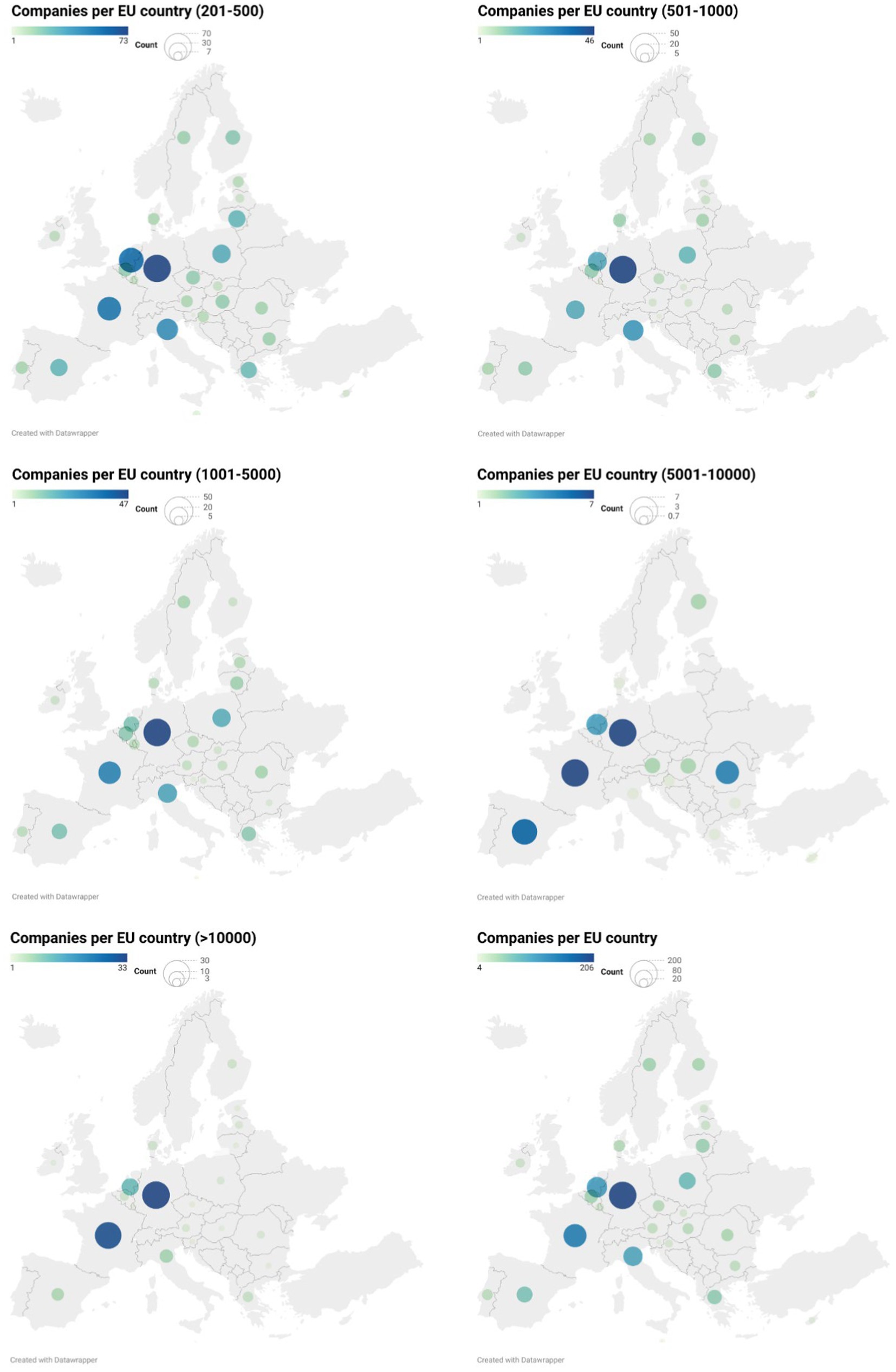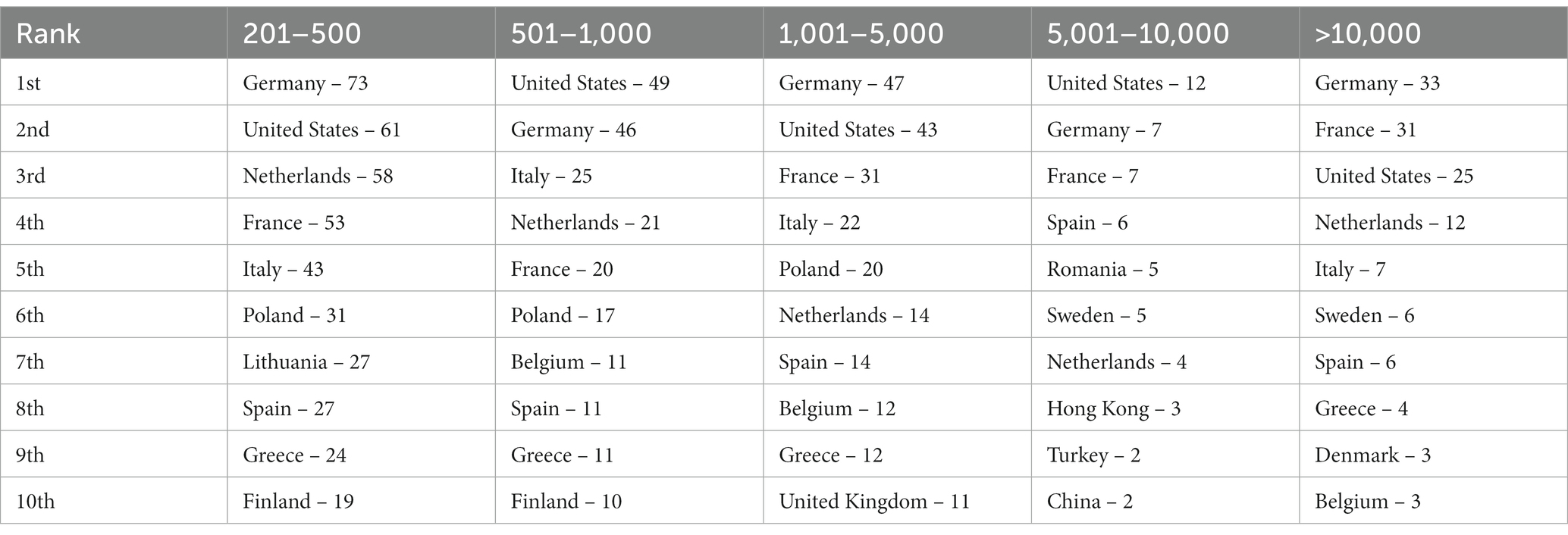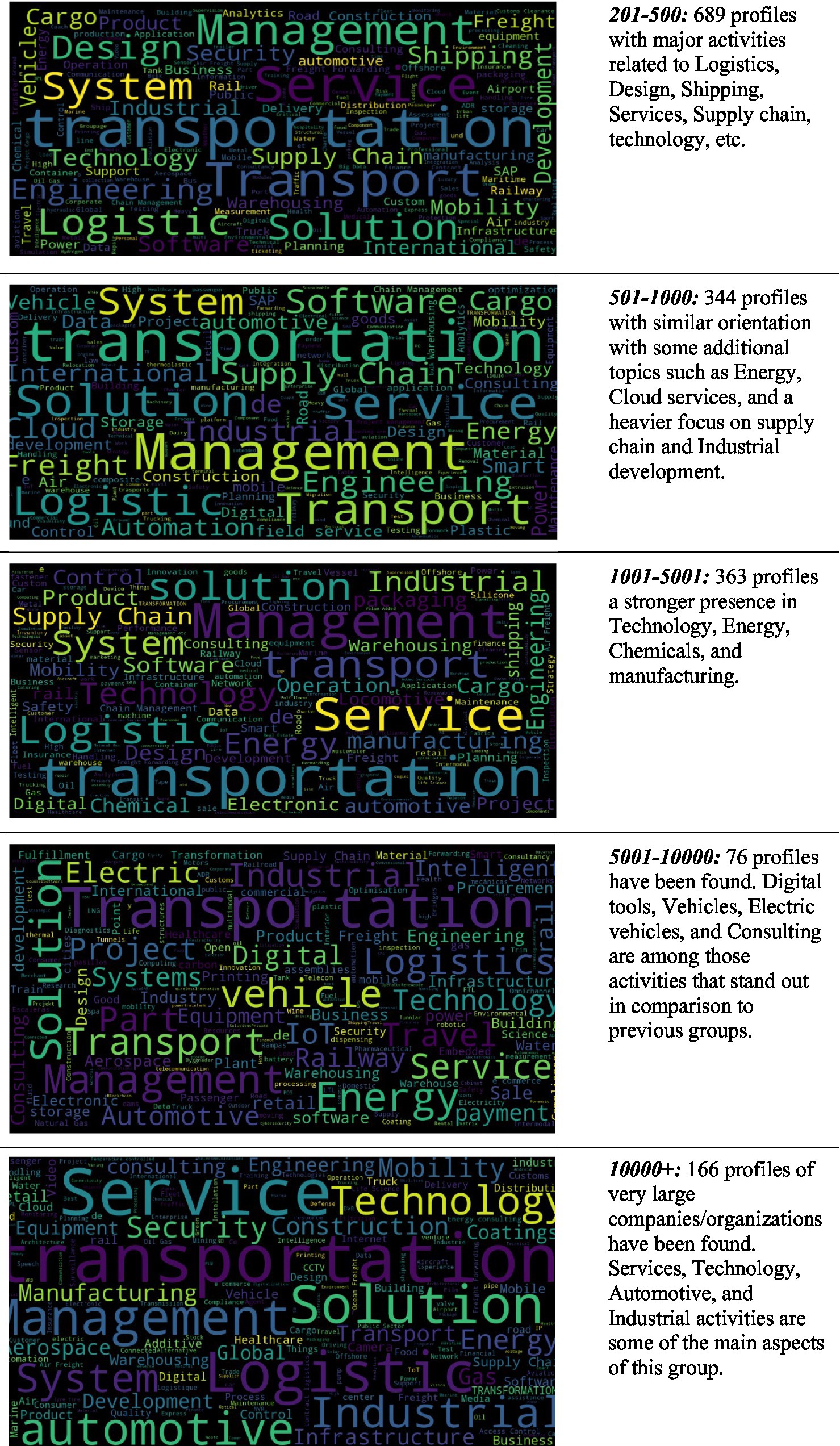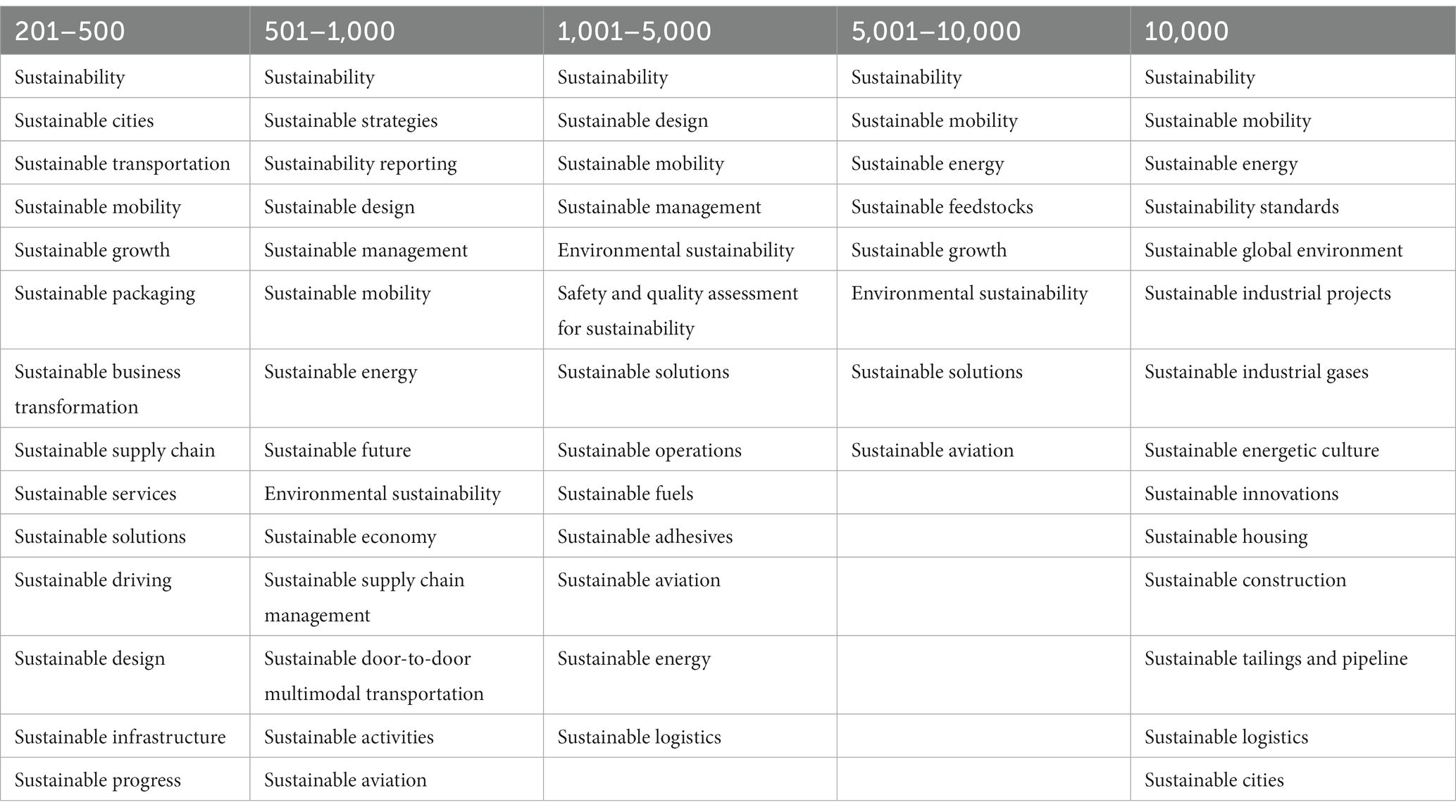- 1Department of Environmental Engineering, Democritus University of Thrace, Xanthi, Greece
- 2Department of Economics, Democritus University of Thrace, Komotini, Greece
- 3School of Production Engineering and Management, Technical University of Crete, Chania, Greece
Sustainability has been a topic of growing interest over the past years with many governments, organizations, and companies trying to achieve the Sustainable Development Goals. The major challenge of implementing more sustainable practices within the corporate environments is still in the foreground, probably even in higher demand, due to the intense environmental degradation and the strict deadlines related to the decarbonization and shift towards greener production systems. Indicatively, the European Commission suggests that transport currently accounts for a quarter of the European Union’s (EU) greenhouse gas emissions and this figure continues to rise as demand grows. In this work, we investigate the transportation sector, distribution systems, and supply chain through the prism of sustainability by mining and analyzing open-access data on the LinkedIn social media platform, which is widely used for professional networking, especially, in the European market. Thus, we extract valuable insights into the current trends around sustainability within the transportation sector. More precisely, 1,638 LinkedIn profiles registered as “companies” related to transportation have been data mined providing valuable outputs regarding their sustainability-oriented activities. Our dataset contains companies with a staff range of over 200 employees, aiming to gain insights from medium SMEs and large organizations. Key findings of our analysis include the differentiation of application areas regarding sustainable concepts and the rise of the percentage of sustainability-related companies with the company staff size combined with a rather strong connection between the United Kingdom’s and United States’s transportation sectors.
1. Introduction
Nowadays, under the threat of extreme and unforeseen occurrences, there has been a global effort toward achieving Agenda 2030 and its sustainable goals. International organizations and institutions have developed several indices within this framework in an effort to track and assess human development while contending with the demands of the physical and technological environment brought on by human activity (Bidarbakhtnia, 2019; Jin et al., 2020; United Nations, 2022). One of the areas that will be hit particularly hard by the effects of climate change in the near future is the transportation sector, making it very important to take immediate action to combat the problem (McKinsey and Company, 2022). Because of the implications of climate change, the whole transportation industry will be very susceptible to its consequences and will need to make significant adjustments to its business practices, infrastructure, and the services it provides. Additionally, other businesses may have an impact on the degree of adaptation and decarbonization measures (Intergovernmental Panel on Climate Change (IPCC), 2018; SLOCAT, 2021).
The transportation sector has been excessively criticized for having a major negative impact on the environment. This is rather expected when considering the CO2 emissions and a series of other air pollutants from internal combustion engines found in means of private and public transport. In this context, there has been a lot of research and development on alternative and sustainable fuels like biodiesel, electricity, ethanol, hydrogen, natural gas, and propane (EERE, U.S Department of Energy, 2023). Additionally, the United States Department of Energy (EERE, U.S Department of Energy, 2023) argues that sustainable fuels can help us achieve a significant gas emission reduction that will lead up to 1.5 degrees Celsius global temperature reduction. On the contrary, there are other more generic actions to be taken toward the shaping of more sustainable cities, where the severity of air pollution is higher. Those measures refer to the public transportation infrastructure improvement combined with citizen-oriented actions like walking and cycling instead of the abusive use of cars (European Commission, 2023).
Moreover, strategic management is becoming more and more crucial to the field of sustainability research and practice globally in terms of the relationship between sustainability and the corporate environment. Many businesses are implementing a range of sustainability initiatives to meet stakeholders’ increasing demands for environmental, social, and governance (ESG) performance while also gaining a competitive edge by incorporating sustainability into their strategy, organizational procedures, and structures (Berg et al., 2021; Ting-Ting et al., 2021). Another critical aspect of the transportation sector is its capability to integrate Sustainable Development Goals (SDGs) set by the United Nations (Gustafsson and Ivner, 2018). Specific domains refer to transport-oriented activities measuring access to infrastructure but lack evaluation metrics on accessibility to activity locations (Brussel et al., 2019). In the same context, Taghvaee et al. (2022), conducted research on the consistency of the maritime transportation sector in Iran, resulting in very poor findings in terms of performance. Further, there is a wide range of SDGs directly related to the transportation sector from different perspectives. Those goals directly relate to Zero Hunger, Good Health and Well-being, Affordable and Clean Energy, Industry, Innovation and Infrastructure, Sustainable Cities and Communities, Responsible Production and Consumption, and Climate Action (Institute of Transportation and Development Policy (IDTP), 2023). The diversity of goals indicates the high importance of the transportation sector and poses the need for further investigation regarding the mapping of business activities on a multinational level.
Several evaluation and reporting methods have also been developed to improve corporate performance in the areas of the environment, society, and the economy while considering the demands and interests of as many stakeholders as feasible. When it comes to transportation companies and the business ecosystem, the participation of stakeholders is a crucial component of strategic planning that is associated with the performance of sustainability (Tafazzoli, 2019; Dimitriou and Karagkouni, 2022a). These papers highlight the need of the transportation sector enterprise and/or projects to promote actions, policies, and measures towards sustainability and corporate social responsibility, providing relevant information to stakeholders, authorities, research society, and decision-makers.
When the goal of a company is to create a high market value at the current time, the management of the company has to concentrate on every aspect of the company’s ramifications, which will contribute to the extraction of valuable insights into the organization. This is necessary so that the firm may achieve its goal. Kocmanová and Dočekalová (2011) state that there is a possibility that environmental actions will result in economic gains. An example of such an implication is how a firm deals with the environment within the context of bearing environmental responsibility. In addition, it is widely acknowledged that there is a potential link between environmental initiatives and economic growth. The implementation of environmentally friendly technologies, as well as the reduction in natural resources usage, along with environmental management systems (EMS) such as ISO 14001 and EMAS, can all be attributed to a secure improvement in the environmental status of the organization. The adoption of environmental management systems has resulted in the development of new possibilities for companies, such as an improvement in the involvement of stakeholders, such as local communities and the authorities, amongst other things.
Numerous unique approaches have been developed especially for the task of studying and evaluating the financial performance of businesses and organizations due to the significance of this task. The main objective of investors and business owners, respectively, is to boost economic performance by utilizing quick and simple approaches (Ilori, 2015). The great majority of companies have as their principal objective to maximize and increase the market value of their products or services. There are many ways to evaluate a company’s success, and how you use them depends on the conditions that are present in the target market at the time. This is because performance standards are subject to modification in line with the target market’s development.
The value of social media data has been highlighted over a decade ago with many social media platforms especially LinkedIn (Bradbury, 2011) and Twitter (Hong and Davison, 2010), offering high-quality data for modeling and analytics. Apart from the “company” profiles, the LinkedIn platform offers great networking opportunities and services to individual users. Personal profiles are probably one of the most important self-promotion tools within the business market, with every recruiter using the LinkedIn platform as the main talent acquisition pool. Additionally, someone’s LinkedIn profile is the first result in Google’s result list, when searched (LinkedIn, 2022). Interestingly, Zide et al. (2014), noticed very early that user profiles present significant differentiations in structure and content across different occupations and backgrounds. Finally, the “Jobs” section is the third out of the most important LinkedIn sections, containing advertisements (posts) about Job openings, usually with a very descriptive and analytical structure.
For this reason, we chose LinkedIn as the main data source for this work aiming to collect and process a large amount of data that is exclusively business oriented. In the past years, there has been a plethora of diverse analytical methods specifically developed for big data and social media. LinkedIn offers semi-structured qualitative and quantitative data accompanied by a search engine that offers a sufficient search optimization process. According to very recent searches (July 8th, 2023), approximately 61,800,000 company profiles are hosted on the LinkedIn platform worldwide, with 25,400,000 of them associated with Europe, and 19,000,000 with the EU. Considering the vast amount of available online data, we conducted research on the current characteristics of the transportation sector and more precisely the qualitative aspects of sustainability in medium and large-sized organizations within the EU.
Following this introduction, Section 2 describes the research context after a state-of-the-art literature review. In Section 3 we analyze the methodology used for our research, Section 4 presents the main findings, Section 5 the discussion, and finally, Section 6 concludes the paper.
2. Literature review
In this section, corporate performance and procedures are discussed the prism of the most important aspects, followed by corporate sustainability governance aiming to set the basis of our research. Then we discuss sustainable business performance pointing out existing policies, strategies, and barriers which is a critical component in understanding the corporate ecosystem of the transportation sector. Finally, we conclude with social media mining and analytics, highlighting the wide acceptance of online publicly available data as a source for statistical analysis that can lead to optimized decision-making.
2.1. Corporate performance and procedures
Numerous studies indicate that the number of shareholder proposals with a social focus that were submitted in 2021 increased by 37% from the prior year (Bruno et al., 2022). Additionally, there is a trend toward more active control using criteria that are getting finer and finer. Even if there are a few various ways to examine ESG problems, research has been focused on a precise approach and full disclosure rather than a move toward less detail. This is the case even though there are a few distinct approaches.
The subject of sustainability studies and practice worldwide is growing more and more dependent on the use of strategic management. Many businesses are taking on a range of sustainability initiatives to meet stakeholders’ increasing demands for ESG performance while also gaining a competitive edge by incorporating sustainability into their strategies, organizational procedures, and structures (Giese et al., 2019; Ting-Ting et al., 2021).
Companies require effective methods to communicate and demonstrate the results that have been accomplished, as well as to monitor and control their behavior to determine whether or not they are effectively responding to the concerns of stakeholders. Focused on the interests and demands of as many stakeholders as is practical, the outputs of the evaluation of sustainability performance and sectorial benchmarking, have to be effectively communicated into the business ecosystem and reporting methods should attempt to widen and integrate financial and economic ways to analyze sustainable corporate performance (Dimitriou and Karagkouni, 2022b). Over the course of more than 20 years, more than a hundred different standards and management methodologies have been established in order to evaluate the sustainable performance of organizations, in terms of their economic, social, and environmental aspects.
By balancing the demands of social tolerance, economic growth, and environmental impact mitigation and by agile policies towards actions, measures, and innovations in usual business, the challenge of corporate sustainable development presents a strategic corporate capability. Stricter laws, increased pressure on businesses and organizations that do not manage waste effectively, and worry over climate change are just a few of the numerous examples that show what society expects from sustainable development (Wassan et al., 2022). Therefore, in corporate strategy and marketing plans, sustainability should be promoted and connected with the core company values, especially in Europe where the Green Deal is the cornerstone of the European market strategic plan.
2.2. Corporate sustainability governance
For sustainable governance to be successful, it is necessary to comprehend perceptions of and conditions for sustainability as well as to incorporate different ethically acceptable values into governance. This knowledge is essential because effective stakeholder consent is required for sustainability governance. Several elements, such as economic effectiveness and circular economy in production lines, environmental and emissions mitigation and company adaptation, management comprehensives, and political legitimacy, must be considered to effectively review performance over sustainability (Frig and Sorsa, 2020). To guarantee that these features are acceptable, the framings must also incorporate several commonly accepted and widely known concepts (Dimitriou, 2018).
As mentioned before, the public and sectorial interest in sustainability performance and practice, worldwide, is growing essential fast. In the transportation sector and the associated industries, the stakeholder’s interests and expectations for ESG aspects of businesses’ sustainability performance have been increased. As a consequence of this, many companies are implementing a variety of sustainability-related measures in order to satisfy these demands and gain a competitive edge by integrating sustainability into their corporate strategy, organizational procedures, and structural designs (Karagkouni and Dimitriou, 2022). This research shows that there are numerous unique pathways related to sustainability-based differentiation via which value can be created. Some of these channels include increased and improved access to financial resources, innovation outcomes, human capital, and employee engagement as well as customer satisfaction as a result of a lower environmental impact and the preemption of rivals who were in the market for those services.
2.3. Sustainable business performance
Effective sustainable transportation business planning considers the social, economic, and environmental elements of transportation in addition to overall development, achieving a balance between the need for immediate outputs and a long-term strategic approach (Nosratabadi et al., 2019). However, in transportation, because of the industry’s decision-making complexity, the level of dependency on energy resources, and the resource-intensive nature of many parts of the transportation chain, this is particularly crucial in the sustainable development of the transportation sector. Therefore, the evaluation of the sustainability performance and the promotion strategy towards effective measures and policies deal with the management performance and reflect the shareholders’ values.
According to the literature, methodologically, there are three key orientations for sustainability performance. The first includes conventional methods of decision-making, including cost–benefit analysis, multi-criteria decision analysis, life-cycle assessment, social life-cycle assessment, and other relevant-oriented approaches, (Dimitriou and Sartzetaki, 2022a). The third explores whether existing regulatory frameworks could be utilized on a corporate or market scale. The second focused on sustainability rating systems, for grading and evaluating sustainability performance, an approach that is stimulating the interest and transportation business ecosystem is widely promoted, (Bueno et al., 2015). Therefore, the promotion of the rating score of sustainability in social media is important in terms of medium-long-term business performance and corporate/enterprise value in the market (including the stock market, investors, etc.).
The sustainability rationale in the transportation sector becomes clearer when taking a longer view. Examples include those investing in resilient infrastructure or renewable energy sources. As was also stated previously, businesses, governments, authorities, and organizations will benefit in the long term from competition to become more sustainable (Haseeb et al., 2019). Because resilient design guarantees that transportation networks can effectively respond to unforeseen events, recurring stressors, and severe shocks related to climate change, it is crucial to ensure sustainable transport development.
Usually, long-term planning is incorporated into the design of large-scale infrastructure projects. Therefore, it is necessary to integrate suitable infrastructural facilities from the start of the project in order to ensure its long-term viability (Bueno et al., 2015; Newman, 2015; Dimitriou and Sartzetaki, 2022b). These preventative measures to safeguard their facilities help to build infrastructure that will be resilient to climate change and other extreme weather events (Dimitriou and Sartzetaki, 2022c). The relationship between the key pillars that promote robust and long-term business performance is depicted in the Figure 1. In terms of corporate business performance, the strategy for the achievement of business resiliency and sustainability varies according to different stakeholders’ interests, goals, and perspectives. The relationship between governmental and regulatory authorities and institutions’ awareness of sustainable development and the business ecosystem is essential, and maintaining a balance between key stakeholders’ expectations could lead to an effective corporate sustainability strategy. In this framework, conducting a sustainability performance assessment of transportation enterprises is crucial to monitor and evaluate key actions and measures taken by management toward the achievement of sustainable development.
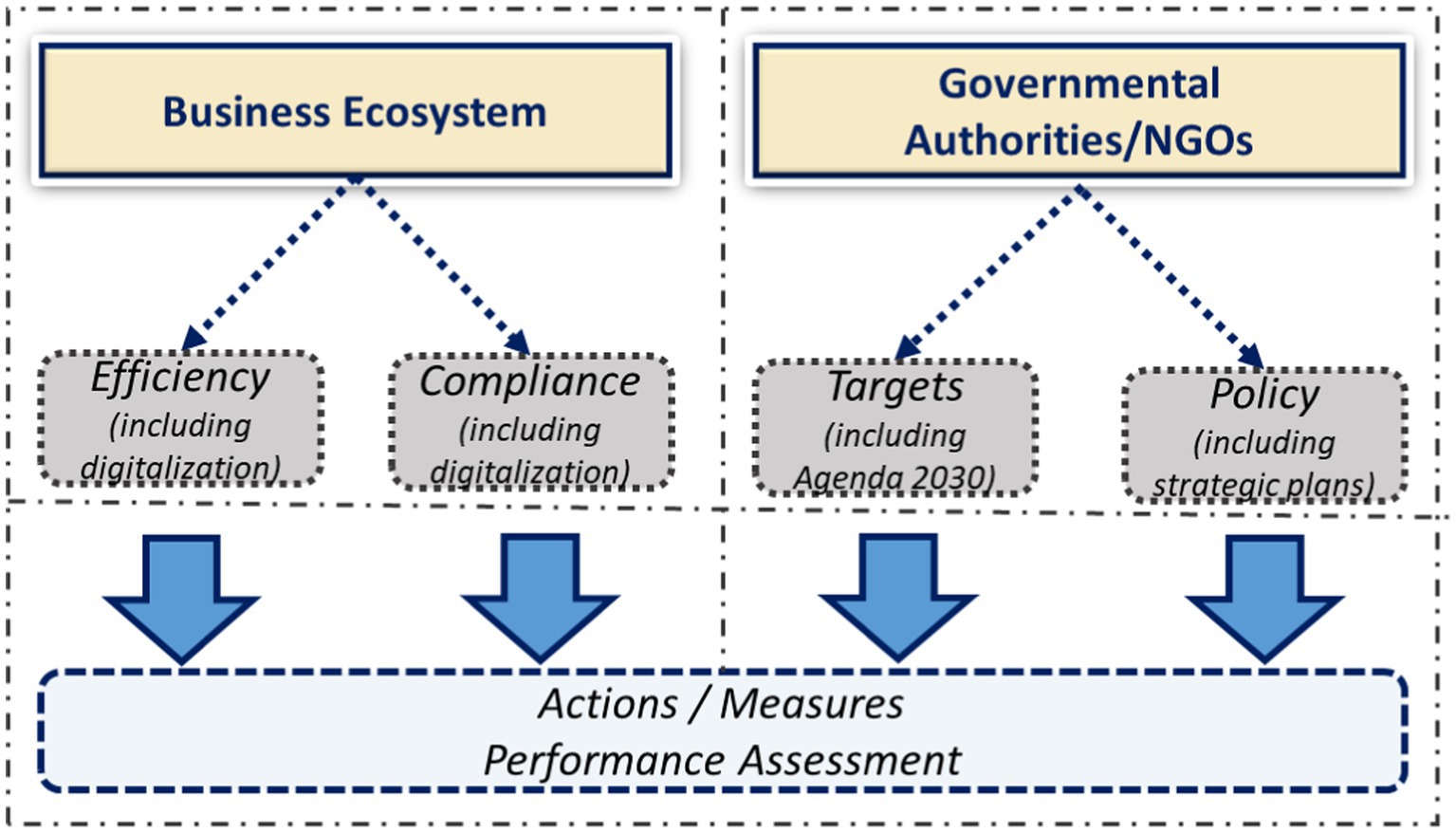
Figure 1. Depiction of stakeholders’ perspective towards resilient and sustainable business performance.
2.4. Social media mining and analytics
Social media platforms have been undeniably considered tools of great value for social and business human interactions. From the LinkedIn perspective, data availability significantly contributes to networking and subsequently improves a person’s or company’s competitiveness and reputation. Consequently, there is a wide range of published works on LinkedIn data focused on different research topics. Previous studies utilize LinkedIn data for business analysis on a European Union and global level, investigating the Circular Economy on a general (Tsironis et al., 2022) or specific industry sector level (Tsironis and Tsagarakis, 2023). A similar analysis has been conducted by Knäble and Tsagarakis (2023), mapping the Circular Economy sector in Germany by analyzing data from every affiliated company’s LinkedIn profile. Further, Hickey et al. (2022) deployed machine learning models on LinkedIn user profiles to gain insights regarding the career differences between genders in the construction industry. In the same context, evidence shows that professional development is positively affected by social networks and LinkedIn can significantly contribute to this outcome (Pena et al., 2022). Finally, direct business analytics can be applied to LinkedIn company profiles since they provide diverse metrics suitable for Time Series Analysis on interactions of different concepts (Daglis et al., 2023) and VAR models monitoring an organization’s follower engagement as a result of the companies’ social presence (Cortez and Dastidar, 2022).
Summing up, based on the previous works, the literature lacks corporate-focused analytics since the weight has been mainly shifted toward user-profiles and job posts, which is still low. To fill this gap in the literature, our work offers a detailed mapping of the “transportation” sector within the European Union and poses the question of whether the mentions of sustainability are aligned with existing academic and corporate reports. Finally, our work verifies prior studies on the positive relationship between a company’s staff and followers.
3. Methodology
In this section, we provide a detailed analysis of the steps taken toward the search term definition, text mining, and text analysis processes. In a general context, we describe in detail the aspects of each methodological step including the search optimization, the data acquisition, and the qualitative and quantitative analysis conducted on our datasets. An overview of the methodological framework is graphically represented in Figure 2.
3.1. Search term definition
As discussed already, transportation is a crucial business sector with high economic growth and environmental impact. In this context, we applied an existing methodology used for the circular economy mapping (Tsironis et al., 2022; Tsironis and Tsagarakis, 2023), on the “transportation” related companies with more than 200 employees based on their LinkedIn profiles. Thus, this work focuses on large SMEs and big enterprises, which usually have more resources to adapt or shift toward sustainable practices. The search query resulted in 1,638 company profiles which correspond to the total number of available profiles on the LinkedIn platform. Thus, there was no sampling process as we managed to obtain the population of the online company profiles. Furthermore, we provide analytics aiming to map the companies’ distributions regarding the industry sectors, and their headquarters locations. We also analyze key profile metrics such as the number of followers and the number of LinkedIn registered employees, to seek any relations among them. Finally, the sequent analysis is developed in parallel according to the 6 clusters of staff range (Figure 3), predefined by the LinkedIn platform. In this way, we answer the question of whether there is a differentiation between the characteristics and strategies of different-sized companies.
3.2. Text mining
LinkedIn offers a vast amount of data related to business activities, including among others, personal profiles, job advertisements, and company profiling. After continuous monitoring and investigation of the profiles under the “Companies” section, we discovered that a set of different entities can be registered as companies. Those entities are usually companies of all types and sizes, organizations, institutes, universities, public services, online shops, etc. Even though there is no absolute homogeneousness among the profiles, all those organizations can provide insights regarding the monitoring of the selected topic in each case. For this reason, we choose to proceed with every profile included in the search query to avoid subjective decisions in profile exclusions. A significant way to reduce the noise in the data was to include larger companies (>200 staff) which automatically excludes some profiles with very few or no staff and followers that can be inactive or even temporal profiles.
Regarding the text mining process, the search term has been initially defined with the “transportation” keyword being placed into the LinkedIn search engine. Further, additional search optimization filters have been set for the acquisition of the desired results; the “companies” profile type has been selected, followed by the definition of the geographical area (EU27 countries) with each country selected individually, and finally the selection of the “company size” categories that excluded the small ones. We performed our search for companies in the EU-27 countries, meaning that we included companies with their headquarters located within the EU. LinkedIn offers the “headquarters location” profile section but also provides the option for a company to register at several other locations of business activity. Thus, many companies with international business activities do not have to create multiple profiles if they have a single headquarters location. As a result, a company that is based in the United States with offices in Germany will be also selected in the search query with the location filter set to “Germany”. The whole process has been conducted within the User Interface (UI) of an external automation tool capable of performing automated time-consuming tasks. After the search definition, the automated process extracted the data included in every profile selected, and the final output was comma-separated values (.CSV) files with the companies placed in individual rows and each profile section corresponding to the columns of the tables. Finally, the CSV files have been converted into Excel (.xlsx) format for further analysis. The graphical representation of the methodological framework followed in this work is presented in Figure 2.
3.3. Data and text analysis
At this stage, every piece of available information has been extracted from the selected company profiles. The output has been qualitative and quantitative data stored in tables which have been mostly handled and analyzed in MS Excel with some additional tools contributing to the visualizations of the results, such as the Datawrapper online platform for map generation and the Python language (v3.11) and PyCharm IDE for the word clouds generation. Initially, all companies regardless of their sustainability relevance have been analyzed in terms of headquarters’ geographical distribution, industry sectors, and year of foundation. Additionally, three different regression models have been deployed, investigating the relation between followers and number of employees. Those two profile sections have been further analyzed in categories, presenting differentiation in key values. Then we pursued text analysis of registries in the “specialties” and “description” profile sections. More analytically, the “specialties” section has been investigated through the prism of the frequency of the most common mentions that can provide insights into the “transportation” sector. On the contrary, the “description” section offers a free text that can provide more detailed information about an organization’s mission and activity. In this context, we investigated every mention related to sustainability by searching for the “sustainab*” keyword within the “description” section.
4. Results
In this section, we first present the industries the selected companies are self-classified, then we make a geographical presentation of those companies, followed by an analysis of the staff and followers. Finally, we perform a transportation and sustainability topic analysis.
4.1. Industries
As companies are classified based on a single industry selected by the page administrator, it is essential to look into how many of them are in each industry. “Transportation/Trucking/Railroad,” “Information Technology & Services,” “Logistics & Supply Chain,” “Electrical & Electronic Manufacturing,” “Computer Software,” and “Mechanical or Industrial Engineering,” are the dominant industry sectors with 426, 131, 121, 67, 65, and 61 company profiles, respectively. Overall, 89 different industry sectors have been found in our analysis with just one company not stating its industry sector as detailed in Table 1.
4.2. Geographical distribution
The geographical distribution of companies reveals that 415 of them have their headquarters outside of the European Union (Figure 4). Overall, countries with more companies outside the EU are the United States of America (191), the United Kingdom (43), Switzerland (24), Canada and Turkey (15), India (14), China (13), the United Arab Emirates (11), Taiwan (11), and Hong Kong (8).
Regarding the distribution of companies in the EU, we provide insights into the geographical distribution overall and per individual cluster defined according to the staff count as a company size measure (201–500, 501–1,000, 1,001–5,000, 5,001–10,000, 10,000+) and collectively for all of them (Figure 5). Table 2 supplements Figure 5 by highlighting the first ten countries per cluster. In all clusters, Germany and the United States are leading the corporate presence, mostly followed by France, Italy, and the Netherlands. The larger clusters also include Poland and Romania in higher ranks (6th) indicating an optimized location strategy for very large enterprises. The dominance of central European countries is evident which indicates inter-country coverage.
4.3. Staff and followers per country
The staff on LinkedIn affiliated with the company profiles indicates an active alignment with its mission. The number of followers shows the social impact of the companies (Tsironis and Tsagarakis, 2023) and is an output of profile information and staff activity. The descriptive statistics of the number of followers for each cluster give an overview of the social-business impact of the studied companies (Table 3). More analytically, there is a rising number of followers as a company’s size grows and very large companies have much more social and business impact on social media platforms. This can be explained when considering the financial resources that can be spent on marketing campaigns.
Among others, LinkedIn offers profile sections that provide valuable metrics of a company’s dynamics. Those metrics mainly refer to the number of followers, and LinkedIn registered employees. To show the role of employees in the promotion of the company’s mission we have run three regression models with the number of followers as a dependent variable based on 1,638 observations (Table 4). Model 1, is explained by the number of staff that has affiliated their profile with the company. Model 2, is explained by the size of the company based on the employees’ range, giving as value the lowest number of employees, i.e., 201 for “201–500″, 501 for “501–1,000″, 1,001 for “1,001–5,000″, 5,001 for “5,001–10,000″ and 10,001 for “>10,000″. Model 3, is explained by both the exploratory variables of Models 1 and 2. R2 for Model 1 is 0.790 while for Model 2 is 0.143. The Adjusted R2 for Model 3 is 0.791, which indicates the followers are related to the staff engaged with the page which is also related to the company’s overall presence on the LinkedIn platform.
Further, the three different models highlight the importance of employees’ engagement in social media. We do not take into consideration any social media action from the side of employees, but we refer to employees who have an active LinkedIn account that is affiliated with the company they work for. This means that a company with 500 employees may have only 10 that have a personal LinkedIn profile “linked” with the company’s profile, in comparison to another company with 100 employees with 80 of them having a personal profile “linked” to the company. The models indicate that the registered employees have a greater impact compared to the actual ones, while those two metrics combined present the highest accuracy.
4.4. Transportation topic analysis
In this part of our analysis, we handle qualitative data that are not predefined by the LinkedIn platform. Each company profile has the option to provide up to twenty comma-separated entries describing the company’s specialties and activities. We found 365 profiles with no registered specialties, corresponding to 22% percent of the 1,638 profiles. The most common concepts found in the clustered datasets are depicted in Figure 6, indicating some differentiations among the staff classes. Initially, the “specialties” of all companies in each cluster have been selected and moved in a different.xlsx file which has been the input to the Python script responsible for the visual outputs. Further, the “pandas,” “wordcloud,” “matplotlib.pylab,” “PIL,” and the “numpy” libraries have been used for code execution. The results indicate a shift towards heavier industrial activities as the company size increases. The largest organizations presented more expertise in electric vehicles, automotive, IoT, and Industrial mentions in general.
4.5. Sustainability topic analysis
Companies have been investing more resources in the development and implementation of sustainable business models and strategies, over the past few decades, with even more effort recently mainly linked to the European Union’s directives, SDGs, and Green Deal. One of the major aspects of this work has been the investigation of companies’ business activities that are related to sustainable concepts. After having a wide view of the “transportation” sector activities, we examined the profiles “description” section aiming to shed light on the level of companies’ engagement in sustainable practices.
Thus, we searched for sustainable mentions within the companies’ “descriptions” by tracking the “sustainab*” keywords. More precisely, the analysis indicated a significant rise in sustainable mentions in companies’ free-text descriptions in relation to their staff count size (Figure 7).
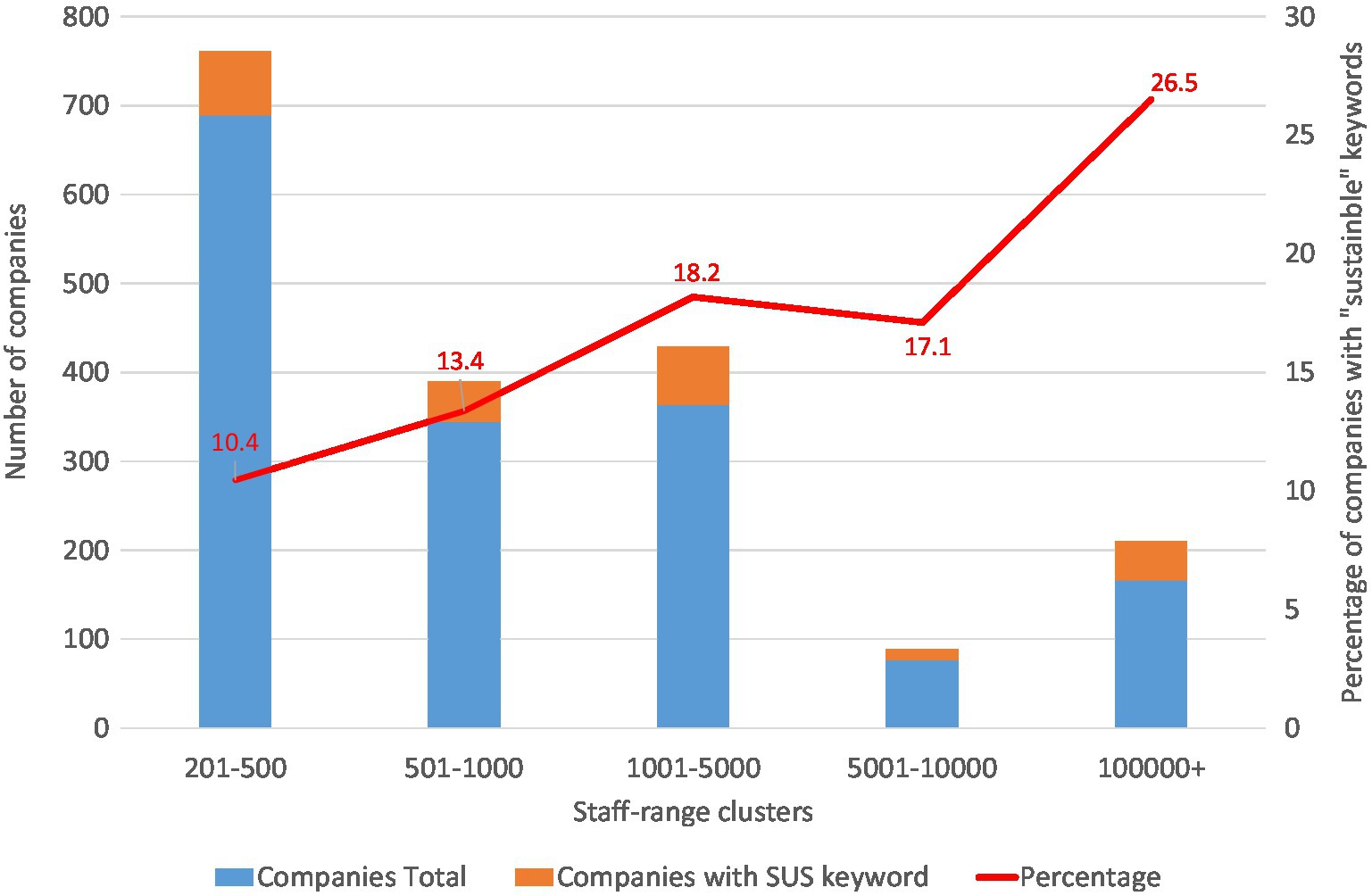
Figure 7. Total number of companies in comparison to the number of “sustainability” related companies, according to their descriptions.
On one hand, many concepts have been horizontally mentioned across the different clusters, including sustainability, aviation, mobility, and energy. On the other hand, we noticed a shift towards more technical or industrial topics as the company size grew. For example, the bigger clusters included topics such as feedstocks, gases, construction, tailing and pipeline, adhesives, etc. It should be noted that many of the common results have been excluded from the table to increase the comparability level (Table 5).
5. Discussion
Previous works have addressed the topic of corporate performance in multi-level analyzes by considering companies’ qualitative and quantitative aspects. After investigating corporate characteristics among different companies, it has been found that innovation is strongly attached to research and development within an organization, which is usually affected by its resources and size (Safitri and Anggara, 2019). Furthermore, Guldmann and Huulgaard (2020) researched the different barriers companies face in their effort to adopt circular economy business models, finding out that larger companies usually face internal barriers but also have some significant advantages regarding external factors such as funding, compared to start-ups and smaller businesses. From another perspective, larger companies invest in environmental innovation as a means to be aligned with national and multi-national regulations and gain further financial support (Andries and Stephan, 2019).
As stated by Bocken et al. (2022), companies that focus their activities on environmental sustainability can refer among others, to ethical working and other strategies that can enhance the product and service operations, in terms of design and production. An essential tool for sustainability enhancement within an organization is learning and education which has been proven to be directly linked to innovation (Silvestre and Ţîrcă, 2019). This is another point of supremacy in larger enterprises which usually have more resources to spend on their employees when it comes to training. On the other hand, it is usually harder for larger organizations to migrate toward completely different operational models mainly in cases where the existing infrastructure performs well in terms of revenue (Gupta et al., 2020; Adams et al., 2023).
The concepts of “sustainable mobility” and “sustainable transportation” have been found across every size cluster of our dataset, indicating its popularity as a business topic. This notion has been researched extensively for over three decades from different perspectives and methodological approaches (Holden et al., 2019). Further, policies implemented for sustainable mobility follow three different directions, Environmental, Socio-Economic, and technological (Gallo and Marinelli, 2020), while others have specifically addressed the topic by pointing out the major importance of fuel reduction and the consumption of alternative “sustainable fuels” (Jeyaseelan et al., 2022).
“Sustainable cities” has been another topic issued by companies on LinkedIn. The corresponding profiles belonged to a journal, a research platform, a research university group, and an urban transportation networks company. Literature-wise, the plethora of relative works addressing smart cities initiatives has presented intuitive prospects. Majumdar et al. (2021), deployed long short-term memory methods to predict congestion based on vehicles’ speed monitored by IoT sensors. Other ways of sustainable transportation include cycling which unfortunately has not attracted much interest in debates on IoT and smart initiatives (Behrendt, 2019). Another interesting finding refers to the positive impact of autonomous cars on the ecological impact of the transportation sector (Chehri and Mouftah, 2019). The aspects of urban transportation systems that can significantly contribute to the proliferation of sustainability also include the development of micro-mobility services (Abduljabbar et al., 2021) and alternative methods of collection and transportation of municipal solid waste (Yadav and Karmakar, 2020). Finally, the policies heavily affect the transition toward sustainable aviation and drive the sector’s adoption of new methods and practices that can aid this transition (Gössling and Lyle, 2021).
Aviation is one of the most polluting industries and raises the question of how to implement strategies and actions toward the “Sustainable aviation” concept. In this context, alternative sustainable fuels have been researched (Heyne et al., 2021), aiming to assess the environmental benefits, with hydrogen demonstrating very promising potential (Yusaf et al., 2022). Engineering, building materials, construction and architecture, cooperative bodies for regional development, outsourcing services for engineering and manufacturing industries, foam manufacturing, aviation navigation services, and airport management have been some of the companies with sustainability and aviation mentions. A key finding regarding company profiles is the existence of companies that refer to many of the aforementioned “sustainable” categories. For instance, some of the companies with mentions of “sustainable aviation” are also relevant to manufacturing, construction, energy, logistics, etc. For this reason, any further discussion on the following topics may include profiles that refer to multiple topics.
“Sustainable energy” is a great example in our dataset of how text-mined material can be confusing in terms of evaluating the level of relevance to the research topic. Two of the companies in our dataset referred to “sustainable energy” as their main activities, are related to sustainable wind energy. These companies must also contain the “transportation” term since the initial dataset consisted of profiles that included this term as the main search query. Thus, we found that These companies mentions the “offshore heavy transportation” activity as another service provided. Further, two more profiles have been found and described as a partnership between universities and institutions, and finally, a supplier of innovative filter, reactor, and transformer solutions. The policies for energy saving and sustainable energy consumption must consider the establishment of reliable databases and transparent information (Lu et al., 2020). As energy production and consumption are considered threatening to the environment, research insights suggest the introduction of technologies that can be cost-effective and customer-friendly (Gunnarsdóttir et al., 2021).
The packaging activities combined with sustainability have been met across our dataset with the most important examples following: adhesives, manufacturing, aluminum manufacturing, thermoplastics, industrial chemicals, food & beverage packaging, transportation of liquid filling products, and carton transport packaging. Many similar findings were included in other profiles highlighting the diversity of activities in the packaging sector. More specifically, packaging is a major manufacturing sector that contributes to environmental pollution. For this reason, alternative materials such as bioplastics have been used aiming at the reduction of environmental impacts (Shlush and Davidovich-Pinhas, 2022). Sustainable packaging adoption also faces some critical cost barriers which are linked to the firm size and the financial resources available for this transition (Afif et al., 2022).
“Sustainable supply chain” and “Sustainable logistics” have been commonly mentioned alongside “sustainable management” as they are usually high-level services of the tertiary sector. The strong dependence of the supply chain on emissions is significantly affected by carbon regulatory policies and determines transportation planning actions (Peng et al., 2022). Modern technologies like Blockchain can have an indirect impact on the supply chain by enhancing sustainability through mapping processes (Khan et al., 2022). Modeling and digitization play a crucial role in the mapping and implementation of sustainable logistics concerning diverse industry sectors (Parhi et al., 2022; Remondino and Zanin, 2022).
In a different context, some companies may use or refer to sustainability as a way to attract consumers or clients, without their actions having a real impact as they claim. This marketing strategy is known as “greenwashing” and is challenging to precisely evaluate an organization’s clarity and processes. In fact, greenwashing can significantly improve a company’s public profile by misrepresentation on a firm or product level (de Freitas Netto et al., 2020). This work has been part of a series of research activities aiming to map the Circular Economy and Sustainability sectors through LinkedIn data in company profiles. Thus, our analysis can significantly contribute to the evaluation of companies’ actual business models or activities through specifically designed questionnaires, by mapping the corporate activities and identifying which organizations can provide a robust sample for further research. An additional improvement of our methodology will be the utilization of LinkedIn APIs to directly integrate with the platform’s database and avoid the web scrapping process. It remains to be seen to what extent the researcher can interact with the database and the volume of data available to the API user.
This also brings the discussion to the limitations of this methodology which are mainly related to the LinkedIn platform itself. Firstly, the most important issue has been the search results limitation to 1,000 profiles which applies to every section (People, Companies, Jobs). This means that the platform returns the number of results which are rounded when exceeding 1,000, but only shows the first 1,000. For this reason, if a text-mining process is needed, the user should modify the search by breaking down the datasets into smaller ones (<1,000) and later merging them while also paying attention to avoid duplicates. Additionally, our findings are aligned with other studies on LinkedIn metrics regarding the behavior of followers in relation to LinkedIn active employees. It should be noted that data quality and observations play a crucial role in modeling as the profiles’ level of completeness significantly affects the output. In our case, the 1,638 observations effectively fitted in a Linear regression model with the results indicating a very strong positive correlation between employees’ and followers’ growth. This finding is aligned with Joglekar and Tan (2022), who pointed out that active and engaging employees can contribute to their company’s attractiveness and reputation.
This work supplements the already existing methodology on LinkedIn text mining and data analysis from a different perspective while also highlighting the need to exploit data from the LinkedIn platform as a means to gain insights regarding business sectors, globally. This gives the advantage of the ease of access to data that alternatively would be hard to acquire since the response rates of questionnaires are usually low. Additionally, even in the case of survey analysis, this methodology can definitely contribute to the first and second-stage data monitoring as a step of an interview process, by creating a pool with those entities that have high relevance to what is been researched and how the survey could be optimized according to their statements and characteristics.
6. Conclusion
Social media networking platforms can play a crucial role in data analytics and business development. Companies are probably the most vital elements of the economy as they drive the markets through product and service development. For this reason, we have further deployed our methodology aiming to shed light on specific sectors and organizations within the European Union. In this work, we investigated medium and large-sized organizations related to the “transportation” concept, as they have been self-classified on the LinkedIn platform. The analysis highlighted the most important concepts and application areas in a general overview while additionally bringing to the surface the most common concepts and practices related to sustainability. The initial research question of whether there is a differentiation among corporate areas of expertise according to their size, has been answered by highlighting some different business activities among the size clusters.
In summary, the value of social media is proven through the deployment of numerous and diverse mining and analytical methods across almost any online networking platform, like LinkedIn, Twitter, Facebook, Instagram, etc. The added value in the exploitation of LinkedIn data lies within the quality and the volume of available information which is significantly business-oriented. That information can highlight patterns and other aspects of selected topics and significantly aid the refinement of strategic planning, decision-making, and network expansion.
Our work provides evidence on corporate and organizational aspects by highlighting the diversity of other industry and business sectors touched by the transportation sector. More specifically, these findings are mainly focused on sustainability mentions in our dataset that testify to the wide range of activities under any industry sector and its relation to the notion of transportation. Additionally, the online data point out the importance of social-media active employees in the organization’s recognition and social-media impact. An organization with high employee engagement in its social media presence can be a determining factor in the attraction of new followers, always combined with the financial resources available for marketing and advertising campaigns.
Data availability statement
The original contributions presented in the study are included in the article/supplementary material, further inquiries can be directed to the corresponding author.
Author contributions
DD: Conceptualization, Formal analysis, Funding acquisition, Methodology, Project administration, Resources, Supervision, Validation, Visualization, Writing – review & editing. GT: Data curation, Formal analysis, Investigation, Resources, Software, Validation, Visualization, Writing – original draft, Writing – review & editing. AK: Formal analysis, Funding acquisition, Investigation, Methodology, Project administration, Resources, Writing – original draft. KT: Conceptualization, Formal analysis, Methodology, Resources, Validation, Visualization, Writing – original draft, Writing – review & editing.
Funding
The author(s) declare financial support was received for the research, authorship, and/or publication of this article. The paper research outputs is supported by the research project “ENIRISST+ − Intelligent Research Infrastructure for Shipping, Supply Chain, Transport and Logistics Plus” MIS5047041 which is implemented under the Action “Reinforcement of the Research and Innovation Infrastructure,” funded by the Operational Programme “Competitiveness, Entrepreneurship and Innovation” (NSRF 2014–2020) and co-financed by Greece and the European Union (European Regional Development Fund).
Conflict of interest
The authors declare that the research was conducted in the absence of any commercial or financial relationships that could be construed as a potential conflict of interest.
The author(s) declared that they were an editorial board member of Frontiers, at the time of submission. This had no impact on the peer review process and the final decision.
Publisher’s note
All claims expressed in this article are solely those of the authors and do not necessarily represent those of their affiliated organizations, or those of the publisher, the editors and the reviewers. Any product that may be evaluated in this article, or claim that may be made by its manufacturer, is not guaranteed or endorsed by the publisher.
References
Abduljabbar, R. L., Liyanage, S., and Dia, H. (2021). The role of micro-mobility in shaping sustainable cities: a systematic literature review. Transp. Res. Part D: Transp. Environ. 92:102734. doi: 10.1016/j.trd.2021.102734
Adams, D., Donovan, J., and Topple, C. (2023). Sustainability in large food and beverage companies and their supply chains: an investigation into key drivers and barriers affecting sustainability strategies. Bus. Strateg. Environ. 32, 1451–1463. doi: 10.1002/bse.3198
Afif, K., Rebolledo, C., and Roy, J. (2022). Drivers, barriers and performance outcomes of sustainable packaging: a systematic literature review. Br. Food J. 124, 915–935. doi: 10.1108/BFJ-02-2021-0150
Andries, P., and Stephan, U. (2019). Environmental innovation and firm performance: how firm size and motives matter. Sustainability 11:3585. doi: 10.3390/su11133585
Behrendt, F. (2019). Cycling the smart and sustainable city: analyzing EC policy documents on internet of things, mobility and transport, and smart cities. Sustainability 11:763. doi: 10.3390/su11030763
Berg, F., Kölbel, J., and Rigobon, R. (2021). Aggregate confusion: the divergence of ESG ratings. Rev. Financ. 26, 1315–1344. doi: 10.1093/rof/rfac033
Bidarbakhtnia, A. (2019). Measuring sustainable development goals (SDGs): an inclusive approach. Global Pol. 11, 56–67. doi: 10.1111/1758-5899.12774
Bocken, N. M., Niessen, L., and Short, S. W. (2022). The sufficiency-based circular economy — an analysis of 150 companies. Front. Sustain. 3:899289. doi: 10.3389/frsus.2022.899289
Bradbury, D. (2011). Data mining with Linked In. Comput. Fraud Secur. 2011, 5–8. doi: 10.1016/S1361-3723(11)70101-4
Bruno, G., Esakia, M., and Goltz, F. (2022). Honey, I shrunk the ESG alpha’: risk-adjusting ESG portfolio returns. J. Invest. doi: 10.3905/joi.2021.1.215
Brussel, M., Zuidgeest, M., Pfeffer, K., and Van Maarseveen, M. (2019). Access or accessibility? A critique of the urban transport SDG indicator. ISPRS Int. J. Geo Inf. 8:67. doi: 10.3390/ijgi8020067
Bueno, P. C., Vassallo, J. M., and Cheung, K. (2015). Sustainability assessment of transport infrastructure projects: a review of existing tools and methods. Transp. Rev. 35, 622–649. doi: 10.1080/01441647.2015.1041435
Chehri, A., and Mouftah, H. T. (2019). Autonomous vehicles in the sustainable cities, the beginning of a green adventure. Sustain. Cities Soc. 51:101751. doi: 10.1016/j.scs.2019.101751
Cortez, R. M., and Dastidar, A. G. (2022). A longitudinal study of B2B customer engagement in Linked In: the role of brand personality. J. Bus. Res. 145, 92–105. doi: 10.1016/j.jbusres.2022.02.086
Daglis, T., Tsironis, G., and Tsagarakis, K. P. (2023). Data mining techniques for the investigation of the circular economy and sustainability relationship. Resour. Conserv. Recycl. Adv. 19:200151. doi: 10.1016/j.rcradv.2023.200151
de Freitas Netto, S. V., Sobral, M. F. F., Ribeiro, A. R. B., and Soares, G. R. D. L. (2020). Concepts and forms of greenwashing: a systematic review. Environ. Sci. Eur. 32, 1–12. doi: 10.1186/s12302-020-0300-3
Dimitriou, D. (2018). Evaluation of tourist airports productivity towards tourism development. Int. J. Cogent Bus. Manage. 5, 1–15. doi: 10.1080/23311975.2018.1464378
Dimitriou, D., and Karagkouni, A. (2022a). Due diligence of transport infrastructure operators sustainability: a circular economy driven approach. Front. Sustain. 3:916038. doi: 10.3389/frsus.2022.916038
Dimitriou, D., and Karagkouni, A. (2022b). Assortment of airports’ sustainability strategy: a comprehensiveness analysis framework. Sustainability 14:4217. doi: 10.3390/su14074217
Dimitriou, D., and Sartzetaki, M. (2022a). Assessment of socioeconomic impact diversification from transport infrastructure projects: the case of a new regional airport, transportation research records (TRR). SAGA 2676, 732–745. doi: 10.1177/03611981211064999
Dimitriou, D., and Sartzetaki, M. (2022b). Modified fuzzy TOPSIS assessment framework for defining large transport enterprises business value. Oper. Res. 22, 6037–6053. doi: 10.1007/s12351-022-00719-9
Dimitriou, D., and Sartzetaki, M. (2022c). Criticality of a regional airport development to mitigate covid-19 economic effects. Int J. Case Stud. Transp. Policy 10, 581–590. doi: 10.1016/j.cstp.2022.01.018
EERE, U.S Department of Energy (2023). Office of Energy Efficiency & Renewable Energy. Available at: https://www.energy.gov/eere/sustainable-transportation-and-fuels (Accessed July 12, 2023).
European Commission (2023). Mobility and Transport. Available at: https://transport.ec.europa.eu/transport-themes/sustainable-transport_en (Accessed July 12, 2023).
Frig, M., and Sorsa, V.-P. (2020). Nation branding as sustainability governance: a comparative case analysis. Bus. Soc. 59, 1151–1180. doi: 10.1177/0007650318758322
Gallo, M., and Marinelli, M. (2020). Sustainable mobility: a review of possible actions and policies. Sustainability 12:7499. doi: 10.3390/su12187499
Giese, G., Lee, L. E., Melas, D., and Nagy, Z. (2019). Foundations of ESG investing: how ESG affects equity valuation, risk, and performance. J. Portf. Manage. 45, 69–83. doi: 10.3905/jpm.2019.45.5.069
Gössling, S., and Lyle, C. (2021). Transition policies for climatically sustainable aviation. Transp. Rev. 41, 643–658. doi: 10.1080/01441647.2021.1938284
Guldmann, E., and Huulgaard, R. D. (2020). Barriers to circular business model innovation: a multiple-case study. J. Clean. Prod. 243:118160. doi: 10.1016/j.jclepro.2019.118160
Gunnarsdóttir, I., Davidsdottir, B., Worrell, E., and Sigurgeirsdóttir, S. (2021). Sustainable energy development: history of the concept and emerging themes. Renew. Sust. Energ. Rev. 141:110770. doi: 10.1016/j.rser.2021.110770
Gupta, H., Kusi-Sarpong, S., and Rezaei, J. (2020). Barriers and overcoming strategies to supply chain sustainability innovation. Resour. Conserv. Recycl. 161:104819. doi: 10.1016/j.resconrec.2020.104819
Gustafsson, S., and Ivner, J. (2018). “Implementing the global sustainable goals (SDGs) into municipal strategies applying an integrated approach” in Handbook of Sustainability Science and Research. World Sustainability Series. ed. W. Leal Filho (Cham: Springer)
Haseeb, M., Hussain, H. I., Kot, S., Androniceanu, A., and Jermsittiparsert, K. (2019). Role of social and technological challenges in achieving a sustainable competitive advantage and sustainable business performance. Sustainability 11:3811. doi: 10.3390/su11143811
Heyne, J., Rauch, B., Le Clercq, P., and Colket, M. (2021). Sustainable aviation fuel prescreening tools and procedures. Fuel 290:120004. doi: 10.1016/j.fuel.2020.120004
Hickey, P. J., Erfani, A., and Cui, Q. (2022). Use of Linked In data and machine learning to analyze gender differences in construction career paths. J. Manag. Eng. 38:04022060. doi: 10.1061/(ASCE)ME.1943-5479.0001087
Holden, E., Gilpin, G., and Banister, D. (2019). Sustainable mobility at thirty. Sustainability 11:1965. doi: 10.3390/su11071965
Hong, L., and Davison, B. D. (2010). “Empirical study of topic modeling in twitter” in Proceedings of the First Workshop on Social Media Analytics. eds. P. Melville, J. Leskovec, and F. Provost (New York, NY, United States: Association for Computing Machinery), 80–88.
Ilori, B. (2015). Corporate strategy, planning and performance evaluation: a survey of literature. J. Manage. Policies Pract. 3, 43–49. doi: 10.15640/jmpp.v3n1a6
Institute of Transportation and Development Policy (IDTP) , (2023) Transport Matters. Available at: https://www.itdp.org/2015/05/26/the-role-of-transport-in-the-sustainable-development-goals/ (Accessed June 25, 2023).
Intergovernmental Panel on Climate Change (IPCC) (2018). Global Warming of 1.5°C. An IPCC Special Report on the Impacts of Global Warming of 1.5°C above Pre-Industrial Levels and Related Global Greenhouse Gas Emission Pathways, in the Context of Strengthening the Global Response to the Threat of Climate Change, Sustainable Development, and Efforts to Eradicate Poverty, Geneva. Available at: https://www.ipcc.ch/sr15 (Accessed June 27, 2023).
Jeyaseelan, T., Ekambaram, P., Subramanian, J., and Shamim, T. (2022). A comprehensive review on the current trends, challenges and future prospects for sustainable mobility. Renew. Sust. Energ. Rev. 157:112073. doi: 10.1016/j.rser.2022.112073
Jin, H., Qian, X., Chin, T., and Zhang, H. (2020). A global assessment of sustainable development based on modification of the human development index via the entropy method. Sustainability. 12:3251. doi: 10.3390/su12083251
Joglekar, J., and Tan, C. S. (2022). The impact of Linked In posts on employer brand perception and the mediating effects of employer attractiveness and corporate reputation. J. Adv. Manage. Res. 19, 624–650. doi: 10.1108/JAMR-10-2021-0343
Karagkouni, A., and Dimitriou, D. (2022). Sustainability performance appraisal for airports serving Tourist Islands. Sustainability 14:13363. doi: 10.3390/su142013363
Khan, S. A., Mubarik, M. S., Kusi-Sarpong, S., Gupta, H., Zaman, S. I., and Mubarik, M. (2022). Blockchain technologies as enablers of supply chain mapping for sustainable supply chains. Bus. Strateg. Environ. 31, 3742–3756. doi: 10.1002/bse.3029
Knäble, D., and Tsagarakis, K. P. (2023). ‘Made in Germany’ how companies approach circular economy on LinkedIn. Eur. Plan. Stud., 1–25. doi: 10.1080/09654313.2023.2228343
Kocmanová, A., and Dočekalová, M. (2011). Corporate sustainability: environmental, social, economic and corporate performance. Acta Univ. Agric. Silviculturae Mendelianae Brunensis 59, 203–208. doi: 10.11118/actaun201159070203
Lu, Y., Khan, Z. A., Alvarez-Alvarado, M. S., Zhang, Y., Huang, Z., and Imran, M. (2020). A critical review of sustainable energy policies for the promotion of renewable energy sources. Sustainability 12:5078. doi: 10.3390/su12125078
Majumdar, S., Subhani, M. M., Roullier, B., Anjum, A., and Zhu, R. (2021). Congestion prediction for smart sustainable cities using IoT and machine learning approaches. Sustain. Cities Soc. 64:102500. doi: 10.1016/j.scs.2020.102500
McKinsey and Company (2022). The Net-Zero Transition: What It Would Cost, What It Could Bring. Available at: https://www.mckinsey.com/capabilities/sustainability/our-insights/the-net-zero-transition-what-it-would-cost-what-it-could-bring (Accessed June 25, 2023).
Newman, P. W. (2015). Transport infrastructure and sustainability: a new planning and assessment framework. Smart Sustain. Built Environ. 4, 140–153. doi: 10.1108/SASBE-05-2015-0009
Nosratabadi, S., Mosavi, A., Shamshirband, S., Zavadskas, E. K., Rakotonirainy, A., and Chau, K. W. (2019). Sustainable business models: a review. Sustainability 11:1663. doi: 10.3390/su11061663
Parhi, S., Joshi, K., Gunasekaran, A., and Sethuraman, K. (2022). Reflecting on an empirical study of the digitalization initiatives for sustainability on logistics: the concept of sustainable logistics 4.0. Clean. Logist. Supply Chain 4:100058. doi: 10.1016/j.clscn.2022.100058
Pena, L., Curado, C., and Oliveira, M. (2022). The contribution of Linked In use to career outcome expectations. J. Bus. Res. 144, 788–796. doi: 10.1016/j.jbusres.2021.09.047
Peng, J., Chen, L., and Zhang, B. (2022). Transportation planning for sustainable supply chain network using big data technology. Inf. Sci. 609, 781–798. doi: 10.1016/j.ins.2022.07.112
Remondino, M., and Zanin, A. (2022). Logistics and Agri-food: digitization to increase competitive advantage and sustainability. Literature review and the case of Italy. Sustainability 14:787. doi: 10.3390/su14020787
Safitri, V. A. D., and Anggara, B. (2019). Factors that Affect the Company Innovation. In II. InTradersUluslararası Ticaret Kongresi Kongre Kitabı the Second InTraders International Conference on International Trade Conference Book (Vol. 230).
Shlush, E., and Davidovich-Pinhas, M. (2022). Bioplastics for food packaging. Trends Food Sci. Technol. 125, 66–80. doi: 10.1016/j.tifs.2022.04.026
Silvestre, B. S., and Ţîrcă, D. M. (2019). Innovations for sustainable development: moving toward a sustainable future. J. Clean. Prod. 208, 325–332. doi: 10.1016/j.jclepro.2018.09.244
SLOCAT (2021). “Integrated Climate and Sustainability Actions”. Available at: https://slocat.net/isdb-slocat-sustainable-transport (Accessed June 25, 2023).
Tafazzoli, M. (2019). “Maintaining the sustainability of critical infrastructure” in Infrastructure Management and Construction. eds. S. M. Sepasgozar, F. Tahmasebinia, and S. Shirowzhan (London, UK: Intech Open).
Taghvaee, V. M., Nodehi, M., Saber, R. M., and Mohebi, M. (2022). Sustainable development goals and transportation modes: analyzing sustainability pillars of environment, health, and economy. World Dev. Sustain. 1:100018. doi: 10.1016/j.wds.2022.100018
Ting-Ting, L., Wang, K., Sueyoshi, T., and Wang, D. (2021). ESG: research Progress and future prospects. Sustainability 13:11663. doi: 10.3390/su132111663
Tsironis, G., Daglis, T., and Tsagarakis, K. P. (2022). Social media and EU companies' engagement in circular economy: a Linked In approach. Sustain. Prod. Consum. 32, 802–816. doi: 10.1016/j.spc.2022.06.006
Tsironis, G., and Tsagarakis, K. P. (2023). Global online networking for circular economy companies in fashion, apparel, and textiles industries, the LinkedIn platform. Curr. Opin. Green Sustain. Chem. 41:100809. doi: 10.1016/j.cogsc.2023.100809
United Nations (2022). The Sustainable Development Goals Report 2022. Available at: https://unstats.un.org/sdgs/report/2022/The-Sustainable-Development-Goals-Report-2022.pdf (Accessed June 25, 2023).
Wassan, A. N., Memon, S., Mari, S., and Kalwar, M. (2022). Impact of Total quality management (TQM) practices on sustainability and organizational performance. J. Appl. Res. Technol. Eng. 3, 93–102. doi: 10.4995/jarte.2022.17408
Yadav, V., and Karmakar, S. (2020). Sustainable collection and transportation of municipal solid waste in urban centers. Sustain. Cities Soc. 53:101937. doi: 10.1016/j.scs.2019.101937
Yusaf, T., Fernandes, L., Abu Talib, A. R., Altarazi, Y. S., Alrefae, W., Kadirgama, K., et al. (2022). Sustainable aviation—hydrogen is the future. Sustainability 14:548. doi: 10.3390/su14010548
Keywords: transportation, sustainability, LinkedIn, sustainability mapping, text mining
Citation: Tsironis G, Karagkouni A, Dimitriou D and Tsagarakis KP (2023) Mapping sustainable practices and concepts in the transportation ecosystem for the EU-27 countries, based on LinkedIn company profiles. Front. Sustain. 4:1268575. doi: 10.3389/frsus.2023.1268575
Edited by:
Firoz Ahmad, Indian Institute of Science (IISc), IndiaReviewed by:
Christian Bux, University of Bari Aldo Moro, ItalyIonica Oncioiu, Titu Maiorescu University, Romania
Copyright © 2023 Tsironis, Karagkouni, Dimitriou and Tsagarakis. This is an open-access article distributed under the terms of the Creative Commons Attribution License (CC BY). The use, distribution or reproduction in other forums is permitted, provided the original author(s) and the copyright owner(s) are credited and that the original publication in this journal is cited, in accordance with accepted academic practice. No use, distribution or reproduction is permitted which does not comply with these terms.
*Correspondence: Dimitrios Dimitriou, ZGltaXRkaW1pdHJpb3VAZ21haWwuY29t
 Georgios Tsironis
Georgios Tsironis Aristi Karagkouni
Aristi Karagkouni Dimitrios Dimitriou
Dimitrios Dimitriou Konstantinos P. Tsagarakis
Konstantinos P. Tsagarakis